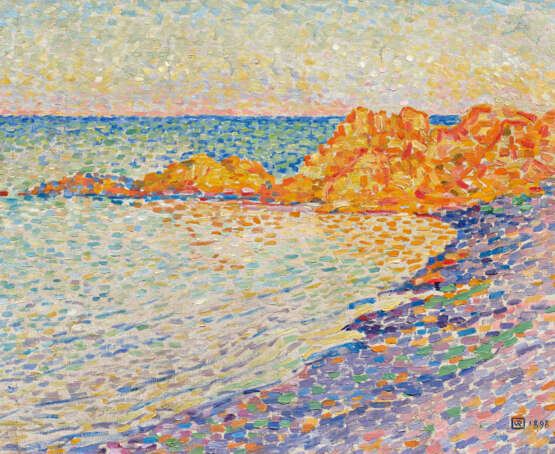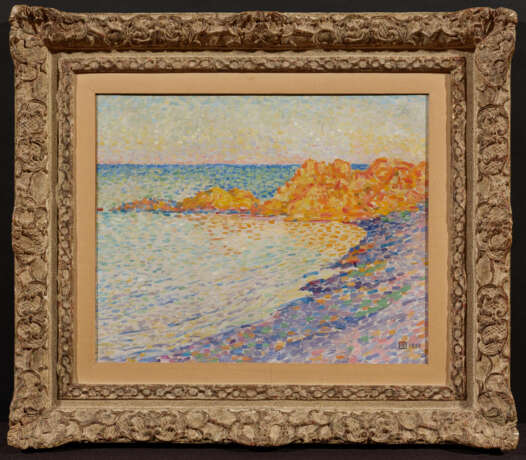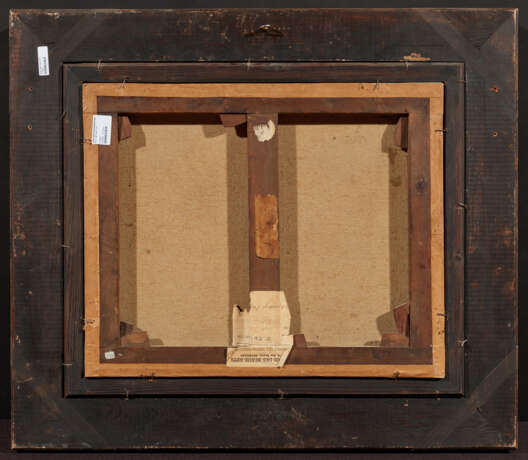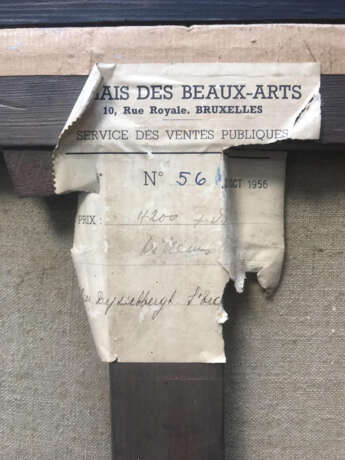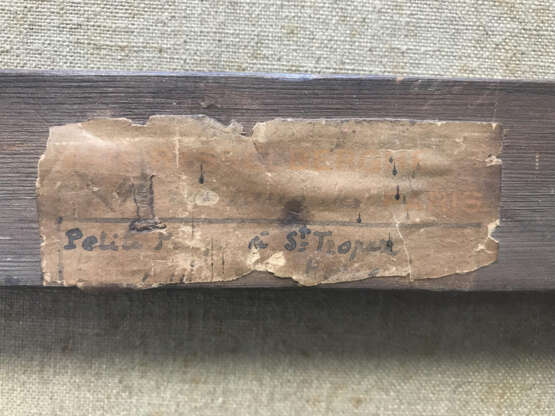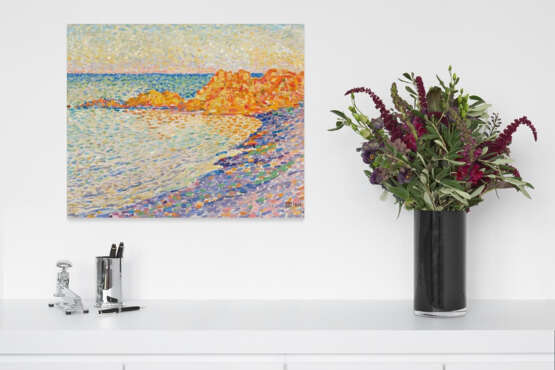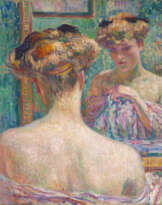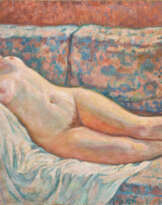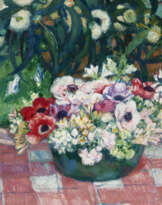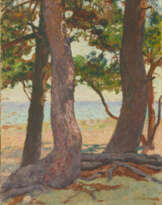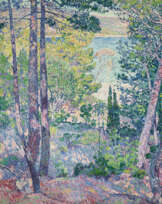Theo van Rysselberghe. Petite plage à Saint-TropezTheo van Rysselberghe. Petite plage à Saint-Tropez
17.05.2024 18:00UTC +01:00
Classic
Vendu
260350EUR € 260 350
| Auctioneer | VAN HAM Kunstauktionen GmbH |
|---|---|
| Lieu de l'événement | Allemagne, Köln |
| Commission | 32% |
Archive
La vente aux enchères est terminée. Vous ne pouvez plus enchérir.

ID 1208202
Lot 1219 | Theo van Rysselberghe. Petite plage à Saint-TropezTheo van Rysselberghe. Petite plage à Saint-Tropez
Valeur estimée
€ 90 000 – 120 000
Title: "Petite plage à Saint-Tropez".
Date: 1898.
Technique: Oil on canvas.
Mounting: Relined.
Measurement: 40,5 x 49cm.
Notation: Monogrammed and dated lower right: "vR 1898".
Frame: Framed.
Verso:
On the stretcher label with handwritten details on the depiction as well as exhibition label Palais des Beaux-Arts, Brussels 30.10.1956.
Literature:
R. Feltkamp: Théo van Rysselberghe 1862-1926, Paris/Brussels 2003, p. 320, no. 1898-021 with ill.
Provenance:
Jean Willems, Brussels;
Private ownership, Germany.
Deserted the bay is lying in front of us. The beach is lying serenely in the blue shadow while sun rays paint the rock formations that protrude into the sea in a warm gold. The sea is calm; the rocks are distinctly reflected in the water surface. Distinctness, however, is, in the context of this small ladscape, a fallacious expression. The colour is whirring and vibrating. There are no firm contours, lines or threedimensional modellings. And yet tha painter has understood to clearly convey the place and its mood.
Théo van Rysselberghe was 35 years old when he painted this atmospheric "portrait" of the little beach near St. Tropez and he had perfected a special form of expression, pointillism, for more or less 10 years.
Van Rysselberghe who had been born in the Belgian town Ghent had been educated in his home town at first, then, however, at the Académie Royale des Beaux-Arts in Brussels from 1879 on. After first participations in the public salon exhibitions in Ghent and Brussels, the young artist could celebrate his first successes in 1882/83 when he presented his travel impressions in exhibitions after an extended stay in Morocco. It was the first of three Morocco voyages during which the young artist already felt fascinated by the southern light. Depicting light became his great challenge and the central theme, to which he committed himself from then on.
When 20 artists organised themselves within the "Société des Vingt" (in short "Les XX") as a group in Brussels in 1883. This society of young avant-garde artists was interested in the exchange with international, primarily French colleagues. Among the members were, amongst others, James Ensor, Ferdinand Khnopff or Félicien Rops. 20 international artists were invited to the annual exhibitions of the "Vingtistes" for giving new impulses to the Belgian art scene but certainly for connecting the Belgian artists internationally, as well. Also because of this progressive concept Brussles became a centre of modern art in the finishing 19th century.
In 1886, Auguste Renoir und Claude Monet exhibited at the "Les XX". Théo van Rysselberghe was deeply impressed by their special new depiction of light and his own so far rathr realist style became inscreasingly impressionist.
Van Rysselberghe, who was already well known in the Parisian art scene, was a driving force behind the "XX" and became the group's "talent scout" in France. He "discovered" Henri de Toulouse-Lautrec as well as his own fellow pupil from his Academy days, Vincent van Gogh, who was able to conclude his only public sale during his lifetime at the group's exhibition in 1890.
However, the most lasting influence on van Rysselberghe's own work was his involvement with the innovative, pointillist painting of George Seurat and Paul Signac, whom he met in Paris in 1886. He was also able to persuade both of them to take part in the "XX" exhibition in Brussels.
While the Impressionists placed the atmospheric depiction of light at the centre of their artistic endeavours, the Pointillists took a radically scientific approach. Colours dabbed onto the canvas in dots were not mixed together, but stood side by side. The picture was to be created in the eye of the beholder, which the painter constructed according to optical laws. The arrangement of the colour values in the spectral circle and the intensification of the complementary contrasts governed his art, with handwriting and brushstrokes taking a back seat.
Van Rysselberghe was the most influential Belgian painter who predominantly used this new technique from around 1888. However, he modified the strict doctrine of pointillism, working with tonal colour values and - as in the example of the present landscape - with short brushstrokes. These strokes (here in the sea waves or in the transition between rocks and water) could also be applied longer and with a different intensity than the "pure doctrine" of pointillism envisaged.
In the year before the present painting "Petite plage à St. Tropez" was created, van Rysselberghe had already painted the same motif in a slightly smaller format. In our later work, the artist has shifted the complementary colours by one shade: from violet-yellow in the earlier painting to a blue-orange contrast. He has also given the sky more space in the present work. This more recent version is richer in contrast and conveys an intense freshness. In 1910, Théo van Rysselberghe, who had lived permanently in Paris since 1898, moved to the Côte d'Azur for the rest of his life.
Here he found the light of the south, which he had already captured so atmospherically in this small landscape.
RYSSELBERGHE, THEO VAN1862 Gent - 1926 St-Clair/Var
Titel: "Petite plage à Saint-Tropez".
Datierung: 1898.
Technik: Öl auf Leinwand.
Montierung: Doubliert.
Maße: 40,5 x 49cm.
Bezeichnung: Monogrammiert und datiert unten rechts: "vR 1898".
Rahmen: Rahmen.
Rückseitig:
Auf dem Keilrahmen Etikett mit handschriftlichen Angaben zur Darstellung sowie Ausstellungsetikett Palais des Beaux-Arts, Brüssel 30.10.1956.
Literatur:
R. Feltkamp: Théo van Rysselberghe 1862-1926, Paris/Brüssel 2003, S. 320, Nr. 1898-021 mit Abb.
Provenienz:
Jean Willems, Brüssel;
Privatbesitz, Deutschland.
Menschenleer liegt die kleine Bucht da. In ruhiger Stimmung liegt der Strand im kühlen blauen Schatten, während Sonnenstrahlen die ins Meer hineinragende Felsformation in warmes, goldenes Licht tauchen. Die See ist ruhig; die Felsen reflektieren recht deutlich in der Wasseroberfläche.
Deutlichkeit ist im Zusammenhang mit dieser kleinen Landschaft allerdings ein irriger Begriff. Die Farbe flirrt und vibriert. Es gibt keine festen Konturen, Linien oder dreidimensionale Modellierungen. Und doch hat der Maler es verstanden den Ort und seine Stimmung eindeutig zu vermitteln.
Théo van Rysselberghe war 35 Jahre alt, als er dieses stimmungsvolle "Porträt" des kleinen Strandes bei St. Tropez malte und er hatte seine spezielle Ausdrucksform, den Pointillismus, seit etwa zehn Jahren vervollkommnet.
Der im belgischen Gent geborene van Rysselberghe war zunächst in seiner Heimatstadt, ab 1879 an der Académie Royale des Beaux-Arts in Brüssel ausgebildet worden. Nach ersten Teilnahmen an öffentlichen Salon-Ausstellungen in Gent und Brüssel konnte der junge Künstler 1882/83 große Erfolge feiern, als er nach einem längeren Marokko-Aufenthalt seine Reiseeindrücke in Ausstellungen präsentierte. Es war die erste von drei Marokko-Reisen, bei der der junge Künstler bereits die Faszination des Lichts des Südens spürte. Licht darzustellen, wurde seine große Herausforderung und das zentrale Thema, dem er sich von nun an widmete.
Als sich 1883 in der "Société des Vingt" (kurz "Les XX") in Brüssel 20 Künstler als Gruppe organisierten, war van Rysselberghe einer von ihnen. Das Interesse dieser Vereinigung junger avantgardistischer Künstler lag in einem Austausch mit internationalen, vornehmlich französischen Kollegen. Unter den Mitgliedern waren u.a. James Ensor, Ferdinand Khnopff oder Félicien Rops. Zu jährlichen Ausstellungen der "Vingtistes" wurden 20 internationale Künstler eingeladen, um der belgischen Kunst neue Impulse zu verleihen, aber sicher auch um die belgischen Künstler international zu vernetzen. Auch dank dieses progressiven Konzepts wurde Brüssel zu einem Zentrum der modernen Kunst im ausgehenden 19. Jahrhundert.
1886 stellten Auguste Renoir und Claude Monet bei "Les XX" aus. Théo van Rysselberghe war tief beeindruckt von ihrer speziellen, neuartigen Darstellung des Lichts und sein eigener, bislang eher realistischer Stil wurde zunehmend impressionistisch.
Van Rysselberghe, der bereits gut in der Pariser Kunstszene bekannt war, war eine treibende Kraft der "XX" und wurde zum "Talentscout" der Gruppe in Frankreich. Er "entdeckte" Henri de Toulouse-Lautrec ebenso wie seinen eigenen Mitschüler aus Akademie-Zeiten Vincent van Gogh, der auf der Ausstellung der Gruppe 1890 seinen einzigen öffentlichen Verkauf zu Lebzeiten abschließen konnte.
Den nachhaltigsten Einfluss auf van Rysselberghes eigenes Werk hatte aber seine Auseinandersetzung mit der neuartigen, pointilistischen Malerei George Seurats und Paul Signacs, die er 1886 in Paris kennenlernte. Beide konnte er auch für eine Teilnahme an der Ausstellung der "XX" in Brüssel gewinnen.
Stellten die Impressionisten die atmosphärische Darstellung des Lichts in den Mittelpunkt ihres Kunststrebens, gingen die Pointillisten diesen Weg radikal naturwissenschaftlich an. In Punkten auf die Leinwand getupfte Farben wurden nicht miteinander vermischt, sondern standen nebeneinander. Im Auge des Betrachters sollte das Bild entstehen, das der Maler nach optischen Gesetzmäßigkeiten aufbaute. Die Anordnung der Farbwerte im Spektralkreis und die Verstärkung der Komplementär-Kontraste regelten ihre Kunst, Handschrift und Pinselduktus traten zurück.
Van Rysselberghe war der einflussreic
| Artiste: | Théo van Rysselberghe (1862 - 1926) |
|---|---|
| Technique appliquée: | Huile |
| Catégorie maison de vente aux enchères: | Peinture 19ème siècle |
| Artiste: | Théo van Rysselberghe (1862 - 1926) |
|---|---|
| Technique appliquée: | Huile |
| Catégorie maison de vente aux enchères: | Peinture 19ème siècle |
| Adresse de l'enchère |
VAN HAM Kunstauktionen GmbH Hitzelerstr. 2 50968 Köln Allemagne | ||||||||||||||
|---|---|---|---|---|---|---|---|---|---|---|---|---|---|---|---|
| Aperçu | |||||||||||||||
| Téléphone | +49 221 92586215 | ||||||||||||||
| Fax | +49 221 92 58 62 4 | ||||||||||||||
| Commission | 32% | ||||||||||||||
| Conditions d'utilisation | Conditions d'utilisation | ||||||||||||||
| Heures d'ouverture | Heures d'ouverture
|
